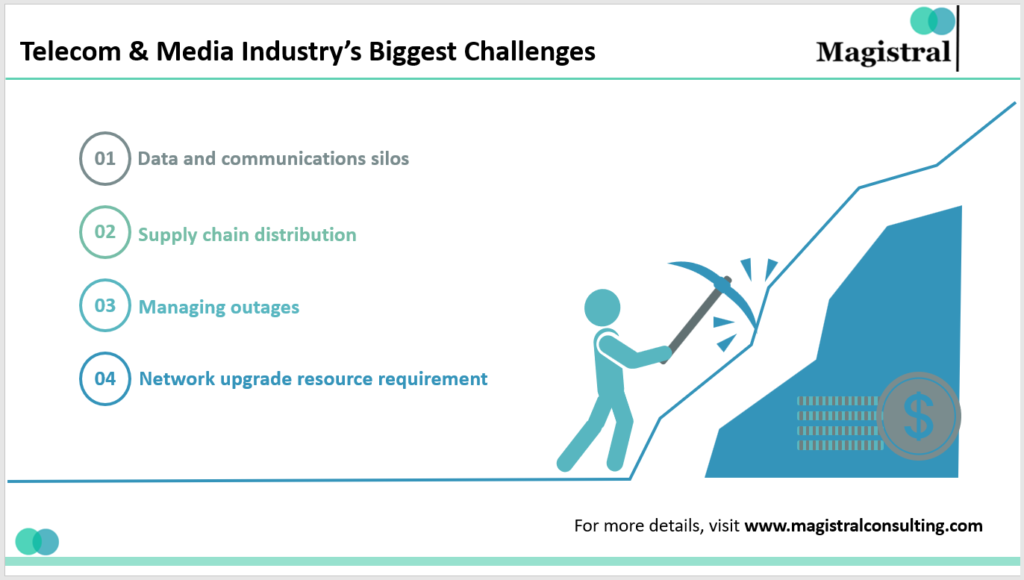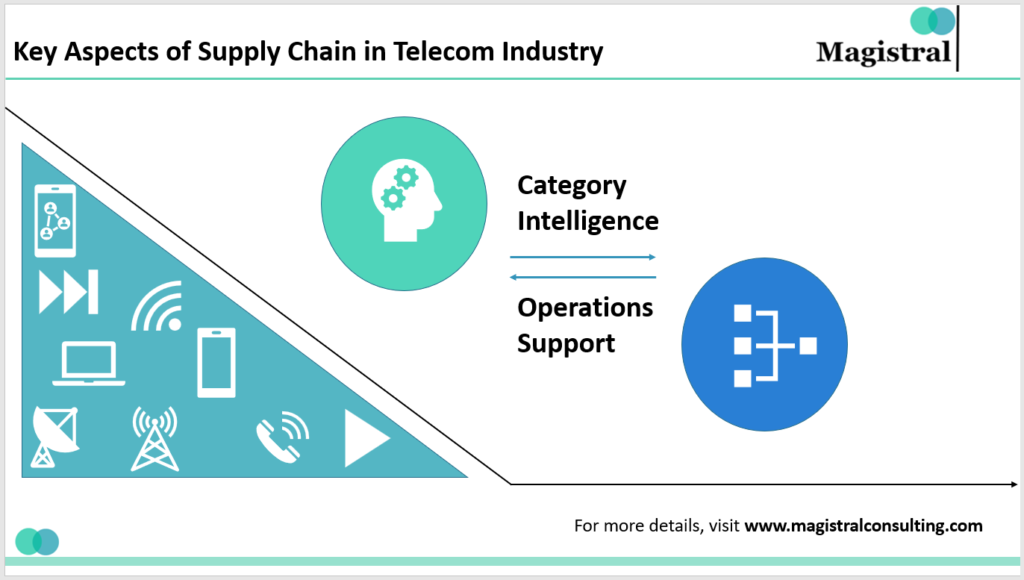Introduction
New digital tools and platforms continue to rewrite the industry regulations as consumer behavior changes. New sources of innovation and competitive advantage are necessary. Reassessing your supply chain is necessary in order to do that. You may prepare your supply chain strategy for telecom and media for today’s and tomorrow’s issues with the aid of supply chain management in the telecommunications industry. Supply chain management offers complete support for the supply chains you employ to provide tangible goods like telephones.
The telecom industry’s severe disruption of the labor and equipment supply chains makes it more challenging to service the growing demand. Lengthened lead times to consumers brought on by problems in the supply chain in once heavily relied-upon manufacturing locations (like China) have a detrimental effect on serviceability and, consequently, revenue.
Efficiency and effectiveness can be used to gauge the functioning of a supply chain. The first is a cost containment indicator, which includes things like warehousing costs, costs associated with inbound and outbound activities, and rising asset turnover. The second reliability indication is order fulfillment, safety stock turnover, and inventory turns. The performance of the supply chain strategy for telecom and media is crucial for a firm to compete in the global market.
The Telecom & Media Industry’s Biggest Challenges
Following are the challenges of telecom and media industries:

Telecom & Media Industry’s Biggest Challenges
Data and Communications Silos.
Data often resides in silos for telecoms firms. Cross-team collaboration is time-consuming due to data being spread across systems for transportation management, customer support, and procurement internally. Externally, telecom businesses frequently correspond manually with suppliers and subcontractors. These data silos cause teams to spend more time manually communicating internally and externally and searching for information across numerous platforms, which slows down the supply chain process. Improving internal data exchange and automating external connections are necessary for greater efficiency.
Improving physical product production and supply chain distribution.
Cell phones and tablets are examples of physical goods that need the standard retail supply chain, which entails planning, sourcing materials, production, delivery, and distribution to both stores and end users’ homes. There are numerous opportunities for improvement throughout the entire process. The production of the physical products and the supply chain for the distribution can be assessed to improve and enhance the sector.
Tracking and managing outages effectively.
You must increase service uptime if you want to keep clients pleased. This entails identifying outages as soon as they occur, tracking out the causes, and sending out maintenance teams or professionals to restore networks to service.
You may improve customer service by designing effective processes and automating as much of the procedure as you can. For instance, the relevant application may open a case in case management, schedule, and dispatch the closest technicians to the area to investigate if there is an outage in a certain place. Bonus points if there is a mobile application that enables technicians to snap images, track the progress of their job, and access knowledge base articles to resolve problems more rapidly.
Numerous resources are needed for network upgrades.
Telecom companies have made large investments in the creation of 5G networks. This massive undertaking requires a great deal of organization, planning, and labor in addition to a wide range of materials, including wires, chips, and physical building materials for new towers. Additionally, as a result of COVID-19, more employees set up home offices, necessitating network upgrades in residential areas that took more time and money to complete. Telecommunications firms’ supply chains must be strong and efficient in order for them to see a return on their investments.
Magistral’s Solutions on Supply chain for telecom and media
Magistral Consulting offers a range of value-added services for the Supply chain strategy for telecom and media industry. Magistral Consulting provides a number of services related to supply chain for the media and telecommunications sector, including:

Key Aspects of Supply Chain in Telecom Industry
Category Intelligence
Demand and Supply Market Analysis:
When making daily decisions, both people and small businesses can more accurately assess market circumstances by analyzing economic principles like supply and demand. The demand curve depicts how much of a commodity or service a consumer will demand at various price points. The market demand curve is the total of all demand curves for a particular commodity or service. Examples of demand and supply analyses cover a number of essential ideas. The quantity of an item or service that will be sold at different price points over a certain length of time is represented by the supply curve in comparison. When examining the supply curve, the relationship between price and quantity delivered is straightforward. The telecom sector is changing quickly as a result of technological advancements and lightning-fast innovation. Additionally, it is a sector whose rules are always changing, offering Communications Service Providers (CSPs) enormous chances for expansion. This future of telecom is being shaped by five primary forces: Value-added Managed Services, 5G, NFV/SDN, Artificial Intelligence, and Machine Learning, Ecosystem Growing Controlled Services. The vulnerabilities and strengths of an industry can be determined using Porter’s Five Forces, a model that identifies and examines five competitive forces that affect every industry. In order to develop company strategy, the structure of an industry is typically identified using the Five Forces analysis.
Pricing Movements and Forecasts:
Finding out what customers are willing to pay for a good or service is the goal of the research technique known as pricing research. Pricing research seeks to establish the best price for new products as well as gauge how price changes affect demand for any offer. When a buyer needs more expensive or complex solutions, they will issue a Request for Proposal (RFP) to potential suppliers. The intent is to solicit business proposals from various suppliers in order to ensure competition, learn more about each supplier’s capabilities and solutions, and gather important market intelligence.
Major Players and Profiles:
A profile will provide you with the fundamental details you require about the company and its operations, including a business overview and essential facts, details on the structure and strategy, information on the leading rivals, significant goods and services, prospects, etc. You can use a SWOT analysis to highlight the company’s advantages, disadvantages, opportunities, and threats as a starting point for future research on the business and/or its rivals.
Negotiation Strategy:
Without considering the precise cost and profit calculations the vendor used to determine the price, pricing analysis is the process of determining if the asking price for a good or service is fair and acceptable. The term “competitive intelligence” refers to the capacity to compile, examine, and apply data on clients, consumers, and other market elements that support a company’s competitive edge.
Custom Intelligence:
Indirect sourcing deals with the provision of sporadic commodities, while direct sourcing concentrates on securing the key supplies that are processed and supplied to your clients.
Impact Assessments:
Assessment for the client over Geo-political events and natural disasters to understand and forecast the impact on the category.
Category Dashboards:
Supply chain dashboards provide supply chain experts with a greater understanding of every component of their supply chain, enabling them to recognize potential problems early and take appropriate action. They also offer tools for monitoring the advancement of different supply chain projects in comparison to predetermined KPIs.
Operations Support:
Outsourcing of processes:
Outsourcing which includes planning, control and reporting processes outsourcing for the client.
Scheduling Production:
In depth effective scheduling of men, material and machine around production as per requirement and goals.
Reports on Production:
Generation of reports on production on basis of shift-wise, daily, weekly, monthly, quarterly and annual reports.
About Magistral Consulting
Magistral Consulting has helped multiple companies to reduce operations costs through its offerings in Procurement and Supply Chain.
For setting up an appointment with a Magistral representative visit www.magistralconsulting.com/contact
About the Author
The article is Authored by the Marketing Department of Magistral Consulting. For any business inquiries, you could reach out to prabhash.choudhary@magistralconsulting.com

